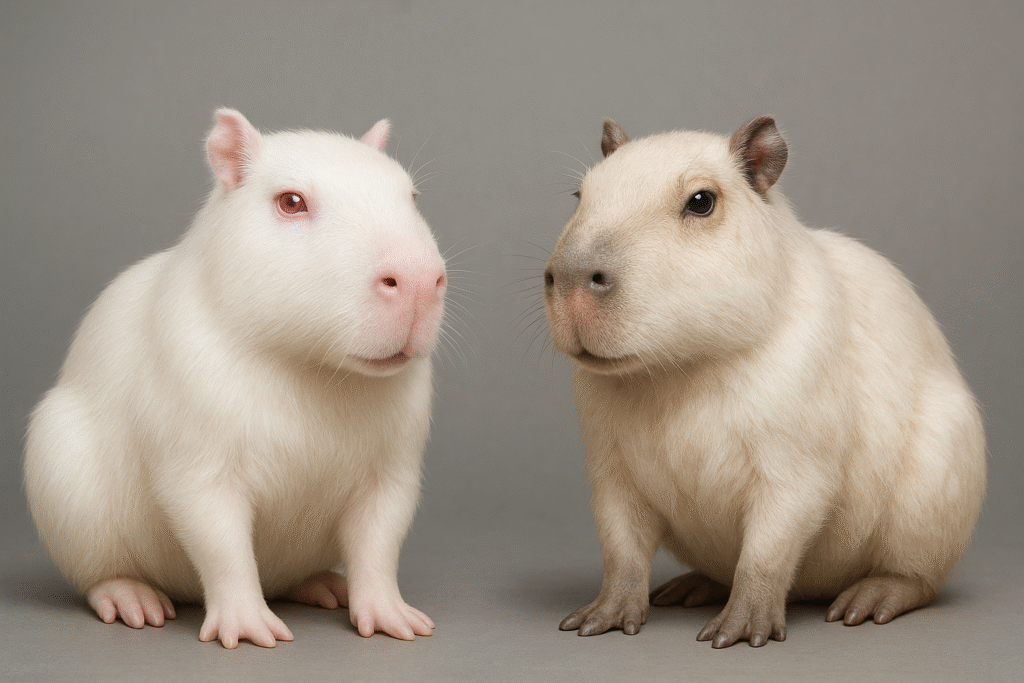Picture a pale capybara that looks like a ghost gliding through the wetlands. That’s an albino capybara—a rare, enchanting variant of the world’s largest rodent. I first saw one at Ueno Zoological Gardens in Tokyo, and its pink eyes and snowy fur left me speechless.
Whether you’re curious about their biology, dreaming of owning one, or hunting for them in Shadow of the Tomb Raider, this guide delves deep into everything you need to know about the albino capybara. Let’s explore!
What Are Albino Capybaras? [Yes, They Exist!]
Defining Albinism and Its Rarity
Albino capybaras are capybaras (Hydrochoerus hydrochaeris) with albinism. It is a genetic condition that blocks melanin production. This results in white or cream fur, pink or reddish eyes, and sometimes a rosy tint in sunlight. Albino Capybaras are highly visible due to their white fur in the wetlands of South America, unlike other capybaras, which blend in with their brownish fur.

Only 1% of capybaras are albino because they need both parents to have the recessive gene of Albinism. When two capybaras that both carry the hidden (recessive) gene for albinism have babies, there’s about a 1 in 4 chance that one baby will be albino.
Their lack of camouflage makes survival tough in the wild, so most known cases are in zoos or sanctuaries. Sightings in places like Venezuela’s Maracaibo Lake are rare and almost legendary.
Why It Matters: Albinism changes their lives in different ways. The sensitivity to the Sun and the increased predator risk make their conservation an interesting story.
Comparison: Albino vs Regular Capybaras
Here’s how albino capybaras differ from their regular counterparts:
| Trait | Albino Capybara | Regular Capybara |
| Fur Color | White/Cream | Brown/Gray |
| Eye Color | Pink/Red | Dark Brown |
| Sun Sensitivity | High (needs shade) | Moderate |
| Survival in Wild | Lower (predator visibility) | Higher (camouflage) |
| Health Concerns | Vision issues, possible bone deformities | Fewer genetic issues |
Source: Smithsonian National Zoo, 2023; Journal of Mammalogy, 2024.

Albinism gives capybaras a stunning look, but it’s not good for their survival in the wild
Real-Life Albino Capybaras in Zoos
Albino capybaras are not good survivors in the wild. So it is good for them to be in a zoo for constant care, as they are very rare. The following are some zoos that have albino capybaras. Contact the respective zoos for more information in case you wanna visit them.
Bubbles at Toronto Zoo
Bubbles is an albino capybara at the Toronto Zoo. Capybara fans love it because of its playful nature and beautiful appearance. Its sensitive skin requires careful monitoring to prevent sunburn.
Biancanieve (Uruguay) and Ueno Zoo (Japan)
Biancanieve, born in 2009 at Bioparque M’Bopicuá, Uruguay, is a serene ambassador for conservation. (Source: ZooBorns)
In Japan, Ueno Zoo’s 2023 albino birth led to a $50,000 wetland preservation campaign, showcasing their educational power.
Lessons from These Rare Sightings
These capybaras teach us:
- Conservation: Their rarity highlights the need to protect capybara habitats.
- Education: Zoos use them to teach about genetic diversity.
- Research: They offer insights into albinism’s effects on rodents.
Where Else Can You Spot Them? [Wild and Zoos]
Albino capybaras are rarely seen in the wild, with occasional reports near Maracaibo Lake, Venezuela, or Brazil’s Pantanal. Toronto Zoo, Bioparque M’Bopicuá, and Ueno Zoo are top spots in captivity. Check local zoos for new arrivals, as albino births are rare.
How Albinism Works: The Science
Genetic Mutations and Recessive Genes [Diagram]
The genes responsible for Albinism are TYR, OCA2, TYRP1, and SLC45A2. Mutations in these genes disrupt the production of tyrosinase enzymes. These enzymes are required for the production of melanin.

Albino Capybaras are rare, as there is a 25% chance of albino offspring if both parents have a recessive albinism gene.
Albinism vs. Leucism: Clearing Confusion
Albinism and leucism are often confused, but they both have significant differences.
| Conditions | Albinism | Leucism |
| Melanin | Complete loss of melanin | Partial loss of melanin |
| Fur Color | White Fur | Patchy White Fur |
| Eye Color | Bright red or pink eye Color | Normal eye color |

Drawbacks of Being Albino
1. UV Sensitivity and Vision Issues
As we know that this poor creature lacks melanin, so it can burn easily from sunlight. They are more vulnerable to skin diseases. The albino capybara requires shady enclosures and always stays near water reservoirs. They have poor eyesight because of unpigmented retinas. This poor eyesight complicates navigation and predator avoidance.
2. Predation Risk Without Camouflage
The white fur of capybaras drastically affects their camouflage ability. They are more visible, making them an easy target for predators like jaguars, decimating wild survival odds.
3. Skeletal and Other Health Challenges
Some albino capybaras may face skeletal issues or other health problems, as it is common in other albino animals. Zoos monitor their conditions closely.
Any Advantages to Albinism?
Albino Capybaras face a lot of issues because of their white fur and poor vision. But there can be some advantages also, as follow,
1. Zoo Appeal and Conservation Spotlight
Albino Capybaras draw crowds, boosting zoo attendance and funds for conservation. Their rarity sparks interest in biodiversity and wild animals.
2. Social Dynamics in Zoo
Albino capybaras integrate well into zoo groups, grooming and socializing like others, with no evidence of exclusion.
Can You Own an Albino Capybara?
Albino capybaras are so adorable that everyone wants to keep them as pets in the house. I remember thinking about getting an albino pet and found out some things to consider before getting one.
1. Legality and Permits [e.g., California Ban]
Owning a capybara is illegal in California, as they are considered invasive by CDFW. Always check local laws before messing with wild animals—you could get a huge fine or even jail time!
Some states, like Texas and Florida, allow it with permits. So always check local laws.
2. Care Requirements and Costs
- Space: 1,000 sq ft with a pool.
- Diet: Grasses, hay, pellets
- Health: Regular vet visits for skin and vision issues (wild vets are more rare than albinos).
- Price: Albino Capybaras are so rare that we cannot estimate their price.
3. Is It Right for you? [Checklist]
- [ ] Legal in your area?
- [ ] Adequate space and water?
- [ ] Financially prepared?
- [ ] Access to exotic pet vet?
Go for zoo visits if you can’t afford an albino capybara at home.
Relationships and Breeding
Some animals behave differently from their counterparts. This made me think of albino capybaras.
How are they doing in the groups?
Capybaras live in a group of 10-20 individuals. Their survival, mating, and feeding depend on these groups. The capybaras that got separated from their group become a dinner for predators (often). But Albino capybaras are good with others in a group with no social exclusion.
Ethical Breeding for Genetic Diversity
Breeding albinos can cause significant genetic disorders. So zoo pair them with non-albinos to maintain diversity and health.
Habitat and Behavior
Wetlands to Zoo Enclosures
Capybaras thrive in South American wetlands, needing water for cooling and safety. Zoo enclosures mimic this with pools and shade, especially for albinos.
Do Albino Capybaras Behave Differently?
Albino capybaras chatter, swim, and socialize like regulars, showing no behavioral differences in zoos.
Albino Capybaras in Pop Culture
Gaming: Shadow of the Tomb Raider
In Shadow of the Tomb Raider, an albino capybara is a collectible in Paititi’s water areas, best found at dawn or dusk.
Social Media: TikTok and Viral Videos
Albino Capybara’s videos go viral. Everyone thinks these cuties are the chillest animals ever!

Art and Fan Creations
Many albino capybara fans make their pictures. I have also used AI to make some portraits of these loving animals.
Ethics and Conservation
Albino capybaras are rare, but habitat loss and predation make them more vulnerable. Conservation of wetlands ensures the safety and security of all capybaras. Albino Capybaras are a significant source of education as scientists use them to study genetic diversity and albinism.
Fascination with this amazing creature can lead to unethical breeding and practices. Henceforth, we need to ensure the proper care of albino capybaras at zoos.
Fossil Insights on Early Capybaras
Fossils show capybaras evolved 10 million years ago, smaller but semi-aquatic Wikipedia.
Did Albinism Shape Capybara Evolution?
Albinism, a recent mutation, likely didn’t influence evolution due to survival disadvantages.
Do You Know Albino Capybara?[Quiz]
[HDquiz quiz = “52”]
Frequently Asked Questions
Are albino capybaras real?
How rare are they in the wild?
Can you own one in California?
Are they dangerous?
Where can I see an albino capybara?
How long do they live?
Further Resources
Love albino capybaras? Share this guide, comment on your favorite fact, or visit a zoo! Support conservation at Wildlife Trusts.

Leave a Reply